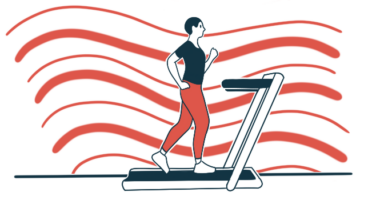High-intensity exercise can boost dopamine signaling in the brain
Exercise's neuroprotective effects seen in 10 participants in 6-month program

Participating in high-intensity exercise can help protect the brain from progressive damage in Parkinson’s disease, a proof-of-concept imaging study suggests.
“This is the first time imaging has been used to confirm that the biology of the brain in those suffering with Parkinson’s disease is changed by intense exercise,” Evan Morris, PhD, a professor at Yale School of Medicine and co-principal investigator of the study, said in a university news story.
The study, “Intense exercise increases dopamine transporter and neuromelanin concentrations in the substantia nigra in Parkinson’s disease,” was published in npj Parkinson’s Disease.
Parkinson’s is caused by the progressive death and dysfunction of cells in the brain that are responsible for making the signaling molecule dopamine. As the disease progresses, dopamine signaling in the brain becomes weaker and weaker, which drives the worsening of symptoms.
Exercise can help improve life quality, symptom severity in Parkinson’s
Research has demonstrated exercise can help improve life quality and ease symptom severity in people with Parkinson’s, but how exercise actually affects their brains hasn’t been studied in detail.
In the study, scientists conducted proof-of-concept research to explore whether exercise influences dopamine signaling in the brains of people with Parkinson’s.
The study included 10 people in the early stages of Parkinson’s who participated in a high-intensity exercise program called Beat Parkinson’s Today. The program was created by Michelle Hespeler, who has Parkinson’s.
“She took all of the elements of high-intensity interval training and combined it with the needs of people with Parkinson’s disease,” said Sule Tinaz, MD, PhD, associate professor of neurology at Yale and co-principal investigator of the study.
The 10 patients in the study participated in a total of 72 hour-long exercise sessions over the course of about six months. Because of the COVID-19 pandemic, the classes took place online. These classes included high-intensity functional intervals to keep participants’ heart rates up throughout the workout. Participants used heart rate monitors to ensure they hit their target heart rates and other wearables like Fitbits to track their movements.
I always tell patients that exercise is a part of their treatment. The same way I prescribe medication, I also prescribe exercise.
Brain imaging measured dopamine activity in regions affected by Parkinson’s
Before and after the six-month program, participants underwent brain imaging to measure dopamine activity in regions that are heavily affected by Parkinson’s.
Results showed that, for nine of the 10 participants, dopamine levels were higher after the six-month exercise program, which is a dramatic contrast to the typical progression of Parkinson’s where dopamine signaling decreases over time. Patients also had higher average levels of the dopamine by-product neuromelanin after the program, which again contrasts with the typical disease course.
“Where we would have ordinarily expected to see a decline in the [dopamine] and neuromelanin signals, we saw an increase,” said Bart de Laat, PhD, the study’s first author and a professor at Yale. “We had hoped to see that the neurodegeneration would not progress as quickly or stop temporarily, but instead we saw an increase in nine out of 10 people. That was remarkable.”
These results suggest that high-intensity exercise may protect the brain in Parkinson’s, supporting the notion that exercise is a key part of managing the disease.
“I always tell patients that exercise is a part of their treatment,” Tinaz said. “The same way I prescribe medication, I also prescribe exercise.”
More studies needed on exercise’s effects on brain health
The researchers noted, however, that this study did not have a control group for comparison, making it difficult to draw definitive conclusions. They suggested future research might compare the effects of high-intensity or more mild exercise programs or no exercise to more clearly understand how exercise affects brain health and what types of exercise will be most beneficial for patients.
The scientists also highlighted that this study enrolled people with early Parkinson’s who had minimal physical impairments and were highly motivated to participate in rigorous exercise, so they stressed further work will be needed to figure out how to translate these findings into actionable advice for patients who may have more difficulty participating in strenuous exercise.
“This proof-of-concept study provides [evidence from living human beings] that sustained periods of intense exercise can induce brain changes in individuals with mild and early [Parkinson’s],” the researchers wrote.
“Our observations could also have far-reaching implications for neuroprotective effects of exercise in [Parkinson’s], but further work is needed to validate them and elucidate the underlying mechanisms,” they concluded.








